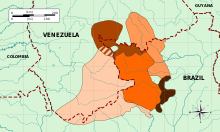Social:Ninam language
Error: no inner hatnotes detected (help).
Yanam, or Ninam, is a Yanomaman language spoken in Roraima, Brazil (800 speakers) and southern Venezuela near the Mucajai, upper Uraricaá, and Paragua rivers.
Synonymy
Yanam is also known by the following names: Ninam, Yanam–Ninam, Xirianá, Shiriana Casapare, Kasrapai, Jawaperi, Crichana, Jawari, Shiriana, Eastern Yanomaman.
Regional variation
Gordon (2009) reports 2 main varieties (Northern, Southern). Kaufman (1994) reports 3:
- Yanam (a.k.a. Northern Yanam/Ninam (Xiliana, Shiriana, Uraricaa-Paragua))
- Ninam (a.k.a. Southern Yanam/Ninam (Xilixana, Shirishana, Mukajai))
- Jawarib
The name Jawari is shared with Yaroamë.
There are three dialects spoken in Roraima, Brazil according to Ferreira, et al. (2019):[3]
- Northern (Xiriana): Ericó and Saúba
- Southern: Mucajaí
- Central: Uraricoera
The remaining speakers of Arutani and Sapé also speak Ninam (Shirián), since they now mostly live in Ninam villages.[4][5]
Phonology
Yanam has seven base vowels. Yanam has both vowel length and nasalization, and both features can occur simultaneously, for all vowels except for /ɨ/.[6]
References
- ↑ Cite error: Invalid
<ref>tag; no text was provided for refs namede25 - ↑ Hammarström, Harald; Forkel, Robert; Haspelmath, Martin, eds (2017). "Ninam". Glottolog 3.0. Jena, Germany: Max Planck Institute for the Science of Human History. http://glottolog.org/resource/languoid/id/nina1238.
- ↑ Ferreira, Helder Perri; Machado, Ana Maria Antunes; Senra, Estevão Benfica. 2019. As línguas Yanomami no Brasil: diversidade e vitalidade. São Paulo: Instituto Socioambiental (ISA) and Instituto do Patrimônio Histórico e Artístico Nacional (IPHAN). 216pp. ISBN:978-85-8226-076-0
- ↑ Rosés Labrada, Jorge Emilio, Thiago Chacon & Francia Medina. 2020. Arutani (Venezuela and Brazil) – Language Snapshot. In Peter K. Austin (ed.) Language Documentation and Description 17, 170-177. London: EL Publishing.
- ↑ Jorge Emilio Rosés Labrada & Francia Medina (2019). Sapé (Venezuela) — Language Snapshot. In Peter K. Austin (ed.) Language Documentation and Description, vol 16. London: EL Publishing. pp. 169-175.
- ↑ "SAPhon – South American Phonological Inventories" (in en). http://linguistics.berkeley.edu/~saphon.
- Campbell, Lyle. (1997). American Indian languages: The historical linguistics of Native America. New York: Oxford University Press. ISBN:0-19-509427-1.
- Kaufman, Terrence. (1994). The native languages of South America. In C. Mosley & R. E. Asher (Eds.), Atlas of the world's languages (pp. 46–76). London: Routledge.
- Migliazza, Ernest; & Grimes, J. E. (1961). Shiriana phonology. Anthropological Linguistics. (June).
External links
 |


